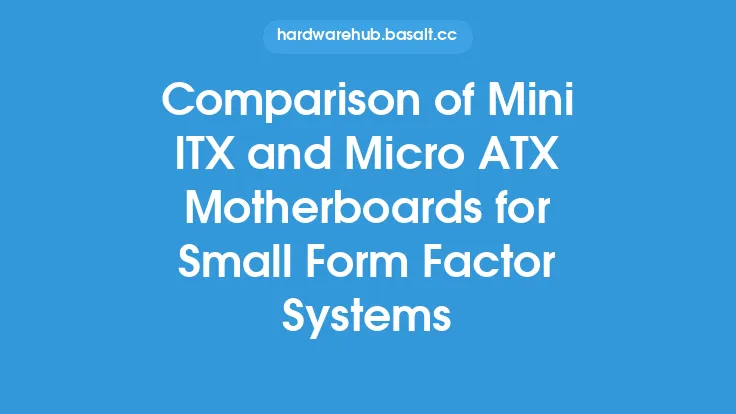The concept of Mini ITX motherboards has been around for several decades, with the first Mini ITX motherboard being introduced in 2001 by VIA Technologies. Since then, the Mini ITX form factor has undergone significant transformations, driven by advancements in technology, changing user needs, and the demand for smaller, more efficient systems. In this article, we will delve into the evolution of Mini ITX motherboards, exploring their past, present, and future.
Introduction to Mini ITX Motherboards
Mini ITX motherboards are a type of small form factor (SFF) motherboard that measures 6.7 inches (17 cm) square. They were designed to provide a compact, low-power alternative to traditional ATX motherboards, making them ideal for small form factor systems, home theaters, and industrial applications. The Mini ITX form factor is characterized by its small size, low power consumption, and flexibility, allowing users to build compact systems that are both powerful and energy-efficient.
History of Mini ITX Motherboards
The first Mini ITX motherboard, the VIA EPIA-5000, was released in 2001. It was based on the VIA C3 processor and featured a range of innovative technologies, including a compact design, low power consumption, and integrated graphics. The EPIA-5000 was designed for embedded systems, industrial applications, and small form factor PCs. Over the years, Mini ITX motherboards have evolved to support a wide range of processors, including Intel Core and AMD Ryzen processors. The introduction of new technologies, such as USB, SATA, and PCIe, has also expanded the capabilities of Mini ITX motherboards, making them more versatile and powerful.
Advancements in Mini ITX Motherboard Technology
The development of Mini ITX motherboards has been driven by advancements in technology, including the introduction of new processor architectures, improvements in power management, and the development of more efficient cooling systems. Some of the key advancements in Mini ITX motherboard technology include:
- The introduction of Intel Core and AMD Ryzen processors, which have significantly improved the performance and power efficiency of Mini ITX systems.
- The development of more efficient power management systems, including voltage regulator modules (VRMs) and power phases, which have reduced power consumption and improved system reliability.
- The introduction of new storage technologies, such as solid-state drives (SSDs) and M.2 NVMe drives, which have improved storage performance and reduced latency.
- The development of more advanced cooling systems, including heat pipes, heat sinks, and liquid cooling systems, which have improved system cooling and reduced noise levels.
Current State of Mini ITX Motherboards
Today, Mini ITX motherboards are more powerful and feature-rich than ever before. They support a wide range of processors, including Intel Core and AMD Ryzen processors, and feature advanced technologies, such as USB 3.2 Gen 2, SATA 6Gb/s, and PCIe 4.0. Many modern Mini ITX motherboards also feature integrated graphics, Wi-Fi, and high-definition audio, making them ideal for small form factor systems, home theaters, and industrial applications. Some of the key features of current Mini ITX motherboards include:
- Support for Intel Core and AMD Ryzen processors
- Advanced power management systems, including VRMs and power phases
- High-speed storage options, including SSDs and M.2 NVMe drives
- Advanced cooling systems, including heat pipes, heat sinks, and liquid cooling systems
- Integrated graphics, Wi-Fi, and high-definition audio
Future of Mini ITX Motherboards
The future of Mini ITX motherboards is exciting, with several new technologies and innovations on the horizon. Some of the key trends and developments that are expected to shape the future of Mini ITX motherboards include:
- The introduction of new processor architectures, such as Intel's Alder Lake and AMD's Zen 4, which will provide significant improvements in performance and power efficiency.
- The development of more advanced power management systems, including gallium nitride (GaN) and silicon carbide (SiC) power devices, which will reduce power consumption and improve system reliability.
- The introduction of new storage technologies, such as phase change memory (PCM) and spin-transfer torque magnetic recording (STT-MRAM), which will provide faster storage performance and lower latency.
- The development of more advanced cooling systems, including liquid metal thermal interfaces and advanced heat pipe systems, which will improve system cooling and reduce noise levels.
Challenges and Limitations of Mini ITX Motherboards
While Mini ITX motherboards offer many advantages, including compact size, low power consumption, and flexibility, they also have several challenges and limitations. Some of the key challenges and limitations of Mini ITX motherboards include:
- Limited expandability, due to the compact size of the motherboard
- Limited power delivery, due to the limited number of power phases and VRMs
- Limited cooling options, due to the compact size of the motherboard and the limited space available for cooling systems
- Limited overclocking capabilities, due to the limited power delivery and cooling options
Conclusion
In conclusion, the evolution of Mini ITX motherboards has been significant, driven by advancements in technology, changing user needs, and the demand for smaller, more efficient systems. From their introduction in 2001 to the present day, Mini ITX motherboards have become more powerful, feature-rich, and versatile, making them ideal for a wide range of applications, including small form factor systems, home theaters, and industrial applications. As technology continues to advance, we can expect to see even more innovative and powerful Mini ITX motherboards in the future, with improved performance, power efficiency, and features.





